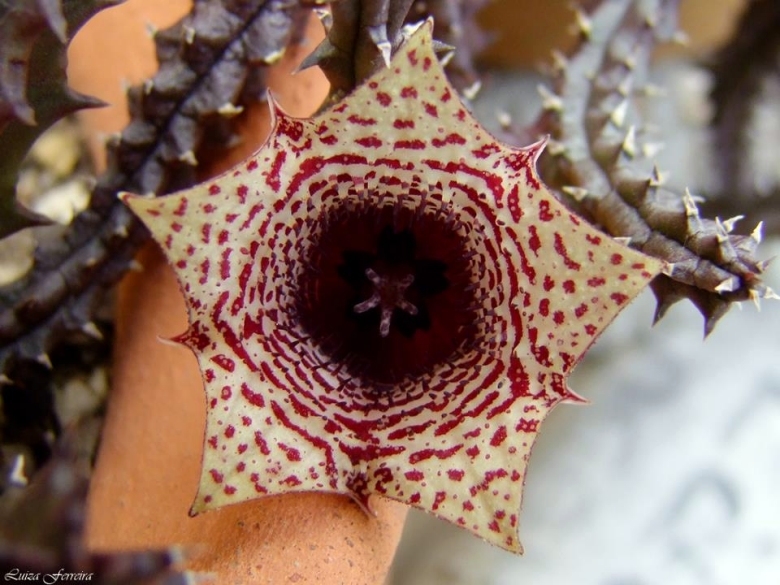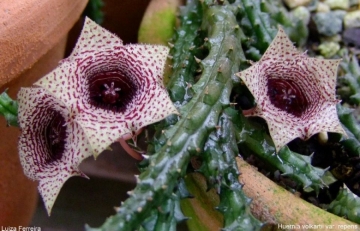Accepted Scientific Name: Huernia volkartii var. repens (Lavranos) Lavranos
J. S. African Bot. 38(1): 43. 1972

Huernia repens (Huernia volkartii var. repens) Photo by: Luiza Ferreira
Origin and Habitat: East Zimbabwe, West Mozambique. Described originally from Garuso Mountain between Umtali and Vila Pery in Mozambique, it has been found in Zimbabwe (ex Rhodesia) on Mangugwe Mountain, at the Tokwe-Mu-korsi dam site 80 km. Miles, south-east of Fort Victoria.
Habita and ecology: Huernia repensSN|28331]]SN|30472]] grows in moss on granite in the mist belt. It is probably close to Huernia stapelioidesSN|30472]]SN|28331]] which occurs in thorn scrub whereas H. vollcartii keeps to higher levels within the mist belt.
Synonyms:
See all synonyms of Huernia volkartii
back
Accepted name in llifle Database:Huernia volkartii Werderm. & Peitsch.Gartenflora 85: 10 1936Synonymy: 3
Accepted name in llifle Database:Huernia volkartii var. repens (Lavranos) LavranosJ. S. African Bot. 38(1): 43. 1972Synonymy: 2
back
Common Names include:
ENGLISH: Dragon flower
Description: Huernia volkartiiSN|30470]]SN|30470]] var. repens (Huernia repensSN|30472]]SN|30472]]) is distinguished from var. volkartii by its longer creeping stems with stem teeth very reduced and leaf-rudiments more or less deciduous. The flowers appear identical with many of those of Huernia volkartiiSN|30470]]SN|30470]], which will necessitate making H. repens a variety of it.
Stems: Long, creeping round with rounded angles and undeveloped teeth. These stems are green during the rains but usually turn reddish brown in the dry winter months.
Flowers: Facing upwards, rarely prostrate or inclined on short peduncles to 10 mm long. Sepals 5.5 -8 mm long. Corolla 2-3 cm in diameter, tube bowl-shaped, c. 10 mm across and half as deep. Corolla outside cream-coloured, inside cream with deep pink transverse lines and dots, rough-papillose, the papillae mottled. Corolla lobes triangular, 4.5-9 mm long, 7-9.5 mm wide. Corona to 7 mm in diameter, 3.5 mm tall, the inner lobes capitate, conically tapering to an oblique fuzzy head from a chinned base.
Chromosome count: 2n = 44.
Subspecies, varieties, forms and cultivars of plants belonging to the Huernia volkartii group
 Huernia decumbens Compton: (= Huernia volkartii var. volkartii) Flowers 1.5-2 cm in diameter creamy-yellow with red transverse irregular lines and dots, rough-papillose, the papillae mottled. Distribution: unknown.
Huernia decumbens Compton: (= Huernia volkartii var. volkartii) Flowers 1.5-2 cm in diameter creamy-yellow with red transverse irregular lines and dots, rough-papillose, the papillae mottled. Distribution: unknown. Huernia volkartii Werderm. & Peitsch.: has stems erect to ascending, 3-5 cm tall, (4- to) 5-angular. Flowers 2-3 cm across creamy with deep pink lines and dots, rough-papillose. Distribution: Angola, Namibia, Zimbabwe, Mozambique.
Huernia volkartii Werderm. & Peitsch.: has stems erect to ascending, 3-5 cm tall, (4- to) 5-angular. Flowers 2-3 cm across creamy with deep pink lines and dots, rough-papillose. Distribution: Angola, Namibia, Zimbabwe, Mozambique. Huernia volkartii var. repens (Lavranos) Lavranos: has longer creeping stems with stem teeth very reduced and leaf-rudiments deciduous. The flowers appear identical with those of H. volkartii. Distribution: E Zimbabwe, W Mozambique
Huernia volkartii var. repens (Lavranos) Lavranos: has longer creeping stems with stem teeth very reduced and leaf-rudiments deciduous. The flowers appear identical with those of H. volkartii. Distribution: E Zimbabwe, W Mozambique
 Huernia repens (Huernia volkartii var. repens) Photo by: Luiza Ferreira
Huernia repens (Huernia volkartii var. repens) Photo by: Luiza Ferreira Huernia repens (Huernia volkartii var. repens) Photo by: Luiza Ferreira
Huernia repens (Huernia volkartii var. repens) Photo by: Luiza FerreiraCultivation and Propagation: Huernia volkartiiSN|30470]]SN|30470]] var. repens isn't difficult to grow and flower.
Spring: When winter ends and they begin to grow again, they will require much water and soaking the pots will no longer put the plants at risk for rot. In the spring they will grow well in partial shade and leaving them out in the rain may provide them with the water they need.
Summer: In the summer months they will tolerate heavy rain, but will be just as happy if the season is dry. It's best to sort out the stems while the plants are resting in the summer before they begin their autumnal growth cycle. They will tolerate very hot weather outdoors as long as they are kept in filtered light and this will encourage them to flower in the Autumn. They also enjoy some fertiliser. Moving the plants as they are developing buds may cause them to spontaneously abort the flowers all together.
Autumn: In the fall keep them outdoors until the night time temperatures drop below the 10°C.
Winter: Winter care presents no problems at 10° C with plenty of light. As soon as they are flowered be sure to take extra precautions to keep them dry, because damp cool conditions when the plants are resting is an invitation to fungal infections, but - according to temperatures –some occasional lit watering may be useful.
Potting medium: Since roots are quite shallow, use a cactus mix or add extra perlite or pumice to regular soil potting soil. A gritty, very free-draining compost is suitable, and clay pots help the plants to dry out between watering. Re-pot every 2 years.
Pest and diseases: Huernia are generally fairly easy to grow, especially if kept pest-free. They are very susceptible to stem and root mealy bugs, and damage from these may well initiate fungal attack. Any time when there is a dead or dying stem in the pot it is important to remove it immediately and completely before other healthy stems can become ill too, isolate the healthy parts, dry them off, and re-root them in new compost.
Propagation: Easiest with stem cuttings. Allow cuttings to dry a day before planting. Stems must be laid (Not buried) on gritty compost and will then root from the underside of the stems. It can also be increased from seeds sowing in spring in moist, sandy peat moss. Barely cover seeds. Seeds germinate quickly.
In any season it's best to lay the stems out for several days before replanting them and then pot them only in dry soil and withhold any water until they begin to shrivel or start growing again.












